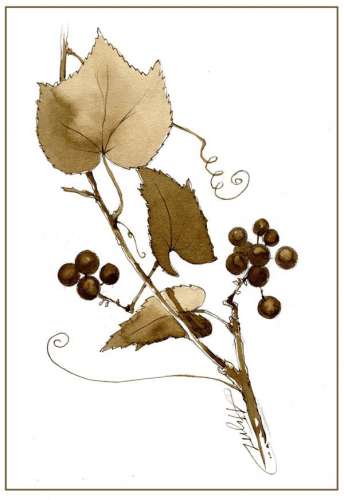
The Norse Vikings referred to the east coast of North America as Vinland, with grapes so plentiful they could be smelled from the sea. Such historical abundance is questionable; the description may have been a marketing ploy similar to the misleadingly named Greenland. Yet wild grapes are plentiful throughout the Northeast and they’re ripening now, to the delight of the many animal species that eat them.
Among humans, European grapes seem to get all the attention. Chardonnay, Bordeaux, and the seedless table grapes found in grocery stores are all cultivars of the Mediterranean grape vine Vitis vinifera. The most common wild species in our area are V. labrusca, the fox grape, and V. riparia, the river grape. Both have remained a forest curiosity since European colonization due to their sour taste and low sugar content. Only the Concord grape, a 19th century V. labrusca cultivar used in juice and jelly, has met with commercial success.
Recently, the growing interest in local agriculture has led members of our own species to give wild grapes a second look. If you look in the right places, maybe you too can find grape vines wrapping around deciduous trees and fences not far from your home. Experienced forager Joshua Fecteau often finds them covering low shrubs, chain link fences, and small trees growing on the edges of clearings. Because wild grapes can smother trees, many forest landowners will be glad to grant you permission for picking and cutting.
Aside from investigating disturbed areas, following other residents of the forest can lead to a copious harvest. They are a favorite fall food of fauna ranging from blue jays to black bears, and an important late-season source of nutrients for many creatures. Birdsong is often an indicator of a wealth of grapes: letting birds serve as your homing beacon may make the hunt more fruitful.
Millennia of braving the thin, acidic soil of New England have made wild grapes tolerant of pH levels between 5.5 and 6.0, and their taste reflects this acidic environment. In comparison to the “intensely sweet” store-bought grapes, Fecteau describes fox grapes as “strongly aromatic” and having a “mild sweetness.” Those grapes receiving the most sunlight tend to be sweeter and less acidic than their shaded peers, but expect stiff competition from birds.
If your harvest is not consumed in the field, wild grape juice, jam, or even wine can be made from your colorful bounty, although patience is required. Naturalist Kyle Sherlock watched an entire baseball game while separating pulp from skins for a batch of fox grape wine, which he described as extremely sour. This drawback became an asset, however, when Sherlock transformed his wine into deliciously tart wild grape vinegar.
You can also collect and use grape leaves in cooking, which are said to far surpass their expensive store-bought peers. Collect them in early summer, before the ripening fruits steal the majority of available carbohydrates.
Wild New England grapes also have potential value for the growing number of Vermont and New Hampshire vineyards. V. riparia especially is of increasing interest to winemakers, as its resistance to frost and disease makes it an excellent candidate for hybridization with the sweeter grapes used traditionally in winemaking. In this process, a shoot from V. vinifera is grafted to the established root system of a V. riparia vine. The resulting hybrid exhibits the sweet, slightly acidic fruits prized for winemaking, while the root system retains the resistance to frost and disease that makes wild grapes ubiquitous even in cold climates. Many commercial hybrids now exist, such as the Frontenac grape developed at the University of Minnesota that can thrive in temperatures as low as -30°F. Perhaps the Sonoma Valley of the 21st century will be right here in New England!
Whether your interest is in wine and grape leaves, or you simply want to partake of the bounty of the forest, would-be grape foragers should heed Robert Frost in his poem “Wild Grapes:”
What are you doing up there in those grapes?
Don't be afraid. A few of them won't hurt you.
I mean, they won't pick you if you don't them.


Discussion *